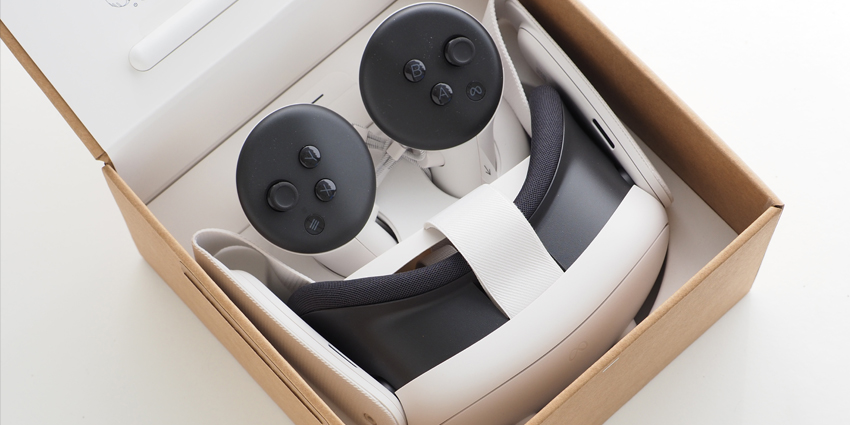ConquestVR (virtual reality) is an immersive audio hardware manufacturer that sells accessories for VR headsets, including Meta Quest, Rift-S, Pico Neo 2, Neo 3, HTC Vive Focus 3 and Varjo Aero.
Prospect buyers can pre-order the firm’s Conquest Pro Headphones for $179.99. The device outputs audio from 20 Hz up to 40,000 Hz. Additionally, the hardware contains an efficient driver design that amplifies spatial audio at a lower power input.
Unboxing our new Conquest VR Headphones! These headphones help you to become even more immersed in your virtual worlds, and we are so excited to have a pair in our office. @ConquestVR
–#unboxing #virtualreality #vr #immersivetech #headphones pic.twitter.com/gYcnBCbGPG— Futurus (@TheFuturus) October 3, 2022
ConquestVR is designing its upcoming product for numerous VR experiences like gaming, training, and remote communication. According to the firm, realistic audio can improve an immersive experience by boosting a user’s sense of presence, situational awareness, and motor performance.
In late October, XR Today’s Rory Greener sat down with the CEO of ConquestVR, Raghu Bathina, to discuss the importance of spatial audio in enterprise environments.
What is Spatial Audio?
Experts like Raghu define spatial audio under various terms, including immersive audio or 3D audio. During the conversation, Bathina noted that spatial audio includes several vital components.
One of those components is spatialization, which simulates a sound’s direction and distance.
Users will hear audio from the left and right in conventional stereo setups, although spatialized audio advances this by enabling users to listen to sounds from all angles, above, below, in front, and behind.
Bathina added: “So it’s like a 360. That’s why it’s also called 3D sound.”
Bathina explained that another aspect of spatial audio is environmental sound, which includes elements like reverbs, occlusion, and the impact of texture on the ground, such as a carpet.
The CEO explained,
“The kind of hall you’re in can give an echoing effect. All of these take into account the environment, and then there are even more advanced features of spatial audio, such as the Doppler shift or the Doppler effect when vehicles pass by. By something known as distance attenuation, which, very simply is how far an object is from you, it [the sound] should sound quieter or louder”
The CEO also added that spatial audio and its foundational components create a more realistic environment similar to real life.
Creating Presence with Spatial Audio
Presence is essential to a successful immersive experience, including virtual, augmented, or mixed reality (VR/AR/MR) applications. Bathina said that whether for entertainment or learning, a benefit of spatial audio is the technology’s ability to simulate a sense of presence.
He said: “Because of the creation of a realistic audio experience, your brain just tells you that you’re actually there.”
ConquestVR enables its hardware adopters to leverage sophisticated spatial audio experiences using its product portfolio. The firm’s product is also compatible with a range of VR headsets allowing users to connect a ConquestVR device to various headset iterations.
During the conversation, Bathina added,
“So we [ConquestVR] said, let’s come up with something which really moves with you as your VR headset moves, is very comfortable to wear, that doesn’t create a lot of sweat, and pressure on your ears. And that’s why we created the Conquest Pro headphones”
What are the Benefits of Spatial Audio for Enterprise Customers?
While spatial audio is increasing in interest within VR gaming circles, the technology is just as crucial for enterprise-grade immersive applications like virtual training, remote guidance, and meeting solutions.
ConquestVR hardware can enhance immersive workplace procedures by stopping common problems of VR headsets like sound leakage.
Bathina added,
“So, a couple of other elements are important for enterprise. One of the things is when you’re in VR [applications], given the current state of VR headsets and the way they’re designed, there is a bit of sound leakage. People around you can hear what you’re doing, in a classroom environment and if you have more than one headset, that can be a problem”
The CEO explained that because of the current state of headset design, external sounds could come in and disturb a user’s sense of presence.
He also added,
“With our headphones, you have almost no sound leakage and almost no sound coming in from outside, so there’s very good passive noise cancellation, and that actually is very useful in an enterprise training environment where you [a trainee] may be doing the training in a more open area”
Bathina noted that overcoming issues like sound leakage was essential from a training perspective. The CEO also explained that creating a sense of presence within an effective immersive training application relies on the core spatial audio output and the hardware a client owns.
If you’re looking for more information on this topic, visit ConquestVR.







